This is my last post for a couple of weeks. I go to Frankfurt tomorrow afternoon to prepare for Diane and Darbi's arrival on the morning of December 15. The three of us then head out for a whirlwind tour of a number of European cities. Come back in January to see pictures and commentary on this part of my "Pursuing Leadership" journey.
My last day in Differdange presented three simple but very important experiences that I will remember fondly. The first was at the conclusion of my afternoon walk - something I usually do before it gets dark each day. I stopped by the Match grocery store, browsing as I've increasingly become comfortable in doing, trying to understand the labels and products. I picked out my merchandise and went to the check out. I was greeted in French and responded in French - "Bon jour." The cashier tallied my items, we exchanged cash, he thanked me and I responded, "Merci." My fantasy is that he never knew I have only the base survival vocabulary in French. This may not seem huge to you but it was a triumph to me. The second experience was at the end of my walk, returning to the Chateau. Have you seen that commercial where a spontaneous soccer game erupts in an Asian market place? Well, this wonderful kid in the school yard was kicking his soccer ball around and when I passed by, he kicked it to me. I laughed out loud and so did he. It was such a warm moment of connection and appreciation of sport and life - without one word spoken. Finally, we had an end-of-the-semester faculty chilli dinner tonight. We all gathered around the table, told stories, and celebrated a great semester. This is the way learning is supposed to be - faculty and students sharing in the common journey and enjoying every minute of it.
These thoughts may not seem that profound but one of the most profound realizations of my European pursuit of leadership is renewing a commitment to the simple things of leadership - relationships, transparency, and conviction. These really are the simple and complex things that challenge us each day. I've found a lot more than a little truth in this pursuit over the past weeks. Come back for more in January. Who know where I'll go.
Tuesday, December 13, 2005
Sunday, December 11, 2005
Saint Nicholas and Christmas in Europe
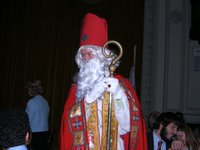
The picture to the right is the European predecessor of Santa Claus - Saint Nicholas. The tradition goes that Saint Nicholas, a Bishop, wanted to brighten the Christmas experience of children who didn't have much so collected presents that he then delivered to them during the holidays. The tradition caught on and after his death, December 6 was designated Saint Nicholas day. This is the day when many Europeans exchange presents, especially with children. In honor of Saint Nicholas' birthday, we celebrated it at the Chateau with a nice dinner and every one of us received chocolate Saint Nicholas likenesses. It was our last official gathering as the fall '05 MUDEC crew - lots of pictures and lost of ambivalent faces over what is quickly passing into only a memory.
I spent the weekend furiously writing away. Part of my commitment as a Visiting Scholar was to work on Deeper Learning in Leadership, a book under contract with Jossey-Bass. The full text has to be in their hands by May 1, 2006. To my great satisfaction, as of tomorrow I will have five of nine chapters finished with over 150 pages of text. It's amazing what you can get done when there are few night and weekend meetings and when my loved ones are 3,000 miles away. I haven't seen a movie since I left the states and I watch little TV except CNN's British coverage. All of this results in a highly productive reading, thinking, and writing environment and I've fully taken advantage of it.
I will sign off of my blog for a while after Diane and Darbi get here. I doubt that I'll have time or the desire to post pictures and commentary to the blog while we're visiting Koln, Bruges, Paris, Geneve, Florence, Rome, Venice, and Salzburg - whew! Come back for a full step by step retrospective once we get back to Oxford on December 30.
In the meantime, I wish you only the best during the holiday. I hope that you have lots of laughs and loving moments to bring you into the New Year.
Thursday, December 08, 2005
German, French and Luxembourg education
I've had the wonderful opportunity to visit four universities while in Europe - one in Trier, Germany, two in Nancy and Metz, France, and the fourth in Luxembourg City. These have stimulated profound reflection on the nature of student affairs work, how we are prepared for it, and the different organization models that can be used to advance it. In the cases of Trier and Nancy/Metz, student affairs is essentially an out-sourced service to address students' logistical needs. In the Luxembourg case, the model is still being developed.
There are very clear dividing lines between academic and non-academic affairs in all of these cases. However, there were fascinating (in my judgment) and unexamined exceptions in crossing these boundaries. Particularly in the case of Nancy, a wonderful cultural programs office is doing some of the most interesting work and I provide more detail on that below. Europeans are curious and a bit surprised that people actually study to prepare for student service/affairs roles. Those in these capacities in Europe have a variety of academic backgrounds and they report being drawn to the work as a personal commitment. They are very dedicated and interested in "serving" students and, for the most part, don't even recognize the powerful impact that they have, or could potentially have, on students' learning. As you might expect, I quoted a few research studies on the impact of out of class experience on student learning and they were curious, although not persuaded. Organizational boundaries, professional preparation, and mental models were all issues that I found inhibit the involvement of all these good people in the work that they hold so dear. These are not unusual inhibitors, even in the U.S. environments where we hope we've made some progress - or have we?
I'm providing more detail notes on the Nancy/Metz visit for those who might have interest.
The functions of student services in Nancy/Metz are application/admission services, on-campus residences for ~10% of the student population, off-campus housing referral as requested, dining, student employment coordination, cultural activities, financial aid analysis and grants, and service to international students (in the Nancy example this includes ~10% of the student population).
Some interesting policies and practices:
• On November 22, 2005, a rather historic agreement concluded that “personal development” is the primary goal of all the student service programs. This agreement was secured through conferences between administrators and the academic staff of the respective campuses.
• While the commitment to “personal development” was agreed among faculty and staff, students will be involved in the consideration of how this will be addressed.
• Technology issues are just emerging in residences. They want to convert to swipe-card access systems and they are attempting to increase the number of computer labs in residences. There is no wireless access as yet.
• Cultural activities include theater, music, dance, and literature but apparently little of the kinds of social activities characteristic of clubs/organizations on U.S. campuses. A particularly effective way to get students involved in these includes competitions for creative works; these come with monetary prizes.
o The cultural mission caused considerable resistance among faculty at first because faculty believed that they were the providers of both academic and cultural learning.
o The cultural activities in which students express the greatest interest are music of all kinds and the “Cultural Action Fund.” This fund is a source of support for students to create their own initiatives (100-1,500 Euro/project).
o Because of the reported “service” commitment and the very clear boundary between in and out of class life, there are no mechanisms to stimulate or assist students in the discovery of learning acquired from out of class experiences. (My observation is that this is happening informally due to the commitment and interest of staff.)
• There is a growing problem among French families being unwilling to assist students with the cost of a university education.
• There are no staff in the residence halls, other than to see to maintenance concerns. My observation is that this is likely the result of the organization model focused on service instead of educational purposes.
Throughout the day, I grew to have greater appreciation for the quality and depth of service being provided by the staff of Nancy/Metz. Although there were repeated statements about the service focus and the clear divisions between in and out of class life, there are very interesting educational/developmental things going on just below the surface. A couple of cultural program examples that are just below the surface and could be explored as deeper learning possibilities are:
o A program called Artem is a community development initiative in partnership with the city of Nancy. While we didn’t get into a lot of detail, this sounds like a community service or service learning initiative. The outcome of this initiative and its potential as a catalyst for learning could be fascinating.
o Because students prefer single rooms and because there appear to be benign divisions between those on campus and those who can pay for private residences off campus, it would be interesting to explore concepts of community – What is is? How it can be enhanced? These campuses seem content in students being very independent, yet, those students we met expressed a desire to connect with their peers. Is community a uniquely U.S. kind of issue or does it have relevance at Nancy/Metz and elsewhere as well?
o The cultural programs office at Nancy has a series of competitions for students in creative endeavor (film, theater, photography, literature). They are now focusing these competitions around themes (almost like Miami has our First-Year Reading focus) and the 2006 focus is “Prison.” Students are allowed to define the theme very broadly so they could address prison as incarceration or they could address prison as the mental frames which constrict our learning and development. I found this idea absolutely fascinating and wondered about its applicability to Miami in a variety of areas.
o The movement into “cultural programs” was resisted, much in the same way that faculty in the U.S. resist the notion that student affairs should have anything to do with the learning mission of the institution. The need to, and provision of services or managerial control, bring certain expectations and may place student affairs staff in boxes that are hard to escape. How can we counter the mental models and confinement of our own experiences?
o The French model is much like the growing trend on some U.S. campuses of out-sourcing. What do we need to learn from the French about the merits or difficulties of such a model? If out-sourcing becomes inevitable, how would a commitment to student development and the enhancement of learning be maintained?
There are very clear dividing lines between academic and non-academic affairs in all of these cases. However, there were fascinating (in my judgment) and unexamined exceptions in crossing these boundaries. Particularly in the case of Nancy, a wonderful cultural programs office is doing some of the most interesting work and I provide more detail on that below. Europeans are curious and a bit surprised that people actually study to prepare for student service/affairs roles. Those in these capacities in Europe have a variety of academic backgrounds and they report being drawn to the work as a personal commitment. They are very dedicated and interested in "serving" students and, for the most part, don't even recognize the powerful impact that they have, or could potentially have, on students' learning. As you might expect, I quoted a few research studies on the impact of out of class experience on student learning and they were curious, although not persuaded. Organizational boundaries, professional preparation, and mental models were all issues that I found inhibit the involvement of all these good people in the work that they hold so dear. These are not unusual inhibitors, even in the U.S. environments where we hope we've made some progress - or have we?
I'm providing more detail notes on the Nancy/Metz visit for those who might have interest.
The functions of student services in Nancy/Metz are application/admission services, on-campus residences for ~10% of the student population, off-campus housing referral as requested, dining, student employment coordination, cultural activities, financial aid analysis and grants, and service to international students (in the Nancy example this includes ~10% of the student population).
Some interesting policies and practices:
• On November 22, 2005, a rather historic agreement concluded that “personal development” is the primary goal of all the student service programs. This agreement was secured through conferences between administrators and the academic staff of the respective campuses.
• While the commitment to “personal development” was agreed among faculty and staff, students will be involved in the consideration of how this will be addressed.
• Technology issues are just emerging in residences. They want to convert to swipe-card access systems and they are attempting to increase the number of computer labs in residences. There is no wireless access as yet.
• Cultural activities include theater, music, dance, and literature but apparently little of the kinds of social activities characteristic of clubs/organizations on U.S. campuses. A particularly effective way to get students involved in these includes competitions for creative works; these come with monetary prizes.
o The cultural mission caused considerable resistance among faculty at first because faculty believed that they were the providers of both academic and cultural learning.
o The cultural activities in which students express the greatest interest are music of all kinds and the “Cultural Action Fund.” This fund is a source of support for students to create their own initiatives (100-1,500 Euro/project).
o Because of the reported “service” commitment and the very clear boundary between in and out of class life, there are no mechanisms to stimulate or assist students in the discovery of learning acquired from out of class experiences. (My observation is that this is happening informally due to the commitment and interest of staff.)
• There is a growing problem among French families being unwilling to assist students with the cost of a university education.
• There are no staff in the residence halls, other than to see to maintenance concerns. My observation is that this is likely the result of the organization model focused on service instead of educational purposes.
Throughout the day, I grew to have greater appreciation for the quality and depth of service being provided by the staff of Nancy/Metz. Although there were repeated statements about the service focus and the clear divisions between in and out of class life, there are very interesting educational/developmental things going on just below the surface. A couple of cultural program examples that are just below the surface and could be explored as deeper learning possibilities are:
o A program called Artem is a community development initiative in partnership with the city of Nancy. While we didn’t get into a lot of detail, this sounds like a community service or service learning initiative. The outcome of this initiative and its potential as a catalyst for learning could be fascinating.
o Because students prefer single rooms and because there appear to be benign divisions between those on campus and those who can pay for private residences off campus, it would be interesting to explore concepts of community – What is is? How it can be enhanced? These campuses seem content in students being very independent, yet, those students we met expressed a desire to connect with their peers. Is community a uniquely U.S. kind of issue or does it have relevance at Nancy/Metz and elsewhere as well?
o The cultural programs office at Nancy has a series of competitions for students in creative endeavor (film, theater, photography, literature). They are now focusing these competitions around themes (almost like Miami has our First-Year Reading focus) and the 2006 focus is “Prison.” Students are allowed to define the theme very broadly so they could address prison as incarceration or they could address prison as the mental frames which constrict our learning and development. I found this idea absolutely fascinating and wondered about its applicability to Miami in a variety of areas.
o The movement into “cultural programs” was resisted, much in the same way that faculty in the U.S. resist the notion that student affairs should have anything to do with the learning mission of the institution. The need to, and provision of services or managerial control, bring certain expectations and may place student affairs staff in boxes that are hard to escape. How can we counter the mental models and confinement of our own experiences?
o The French model is much like the growing trend on some U.S. campuses of out-sourcing. What do we need to learn from the French about the merits or difficulties of such a model? If out-sourcing becomes inevitable, how would a commitment to student development and the enhancement of learning be maintained?
Monday, December 05, 2005
Habsburg legacy of leadership and service
If you read the previous posts about Vienna, you know that I'm a huge fan and believe Vienna is one of the greatest cities in Europe. However, experiences like this tend to linger in my mind for a while until other implications surface. Over the last 24 hours I've begun to reflect on the legacy of leadership and service left by 600 years of monarchy, one of the longest periods of dynasty in 2000 post-A.D. years. Before you read further, I want to note that I do not stand in judgment. We are all products of our own time and context. The thing that strikes me and calls me to offer a "note to self" at the beginning of this entry is the realization that we have a legacy, whether intended or not. And the note to self is to be sure that what I stand for is unequivocal and consistent so that, should anyone care, there is little room to question my intent.
The Habsburg family left an incredible city and other cities and palaces throughout Europe. In fact, one of the sets of porcelain on exhibit at the Hofburg was a special set with pictures of all the palaces and castles in the family name at the time the dishes were made. The art, architecture, music, and culture supported by the Habsberg family was monumental. Much of the art so highly valued today would never have been completed had it not been for the sponsorship of the family. Christianity has a great deal it owes to the Habsburgs. During the reign of the family, the Turkish empire extended into Eastern Europe and twice encroached upon Austria, only to be repelled in subsequent battles. The adventure of the protection of Christianity in fact was dramatized by ladies at court who road in their fine carriages in the Spanish riding school, pretending to fight battles with the "Turks" in the arena. Incidentally, the pattern of their drama and the carriages in which they road became known as the carousel, from which the notion of the modern carousels in amusement parks is derived. The Habsbergs were a benevolent monarchy for the most part. They even melted down their house gold and silver when the financial burden of wars required liquidation of ready assets to fund the cost. However, at what cost, to whom, and for what purpose? This is where my reflections turn...
The Habsburgs did incredible things to create a cultured and advancing Europe. But their privilege was always the first and foremost being protected. War - whose war? Was it war for the people or war to protect the ruling prerogative of the Habsburg family? So what that they melted down the family jewels and serving pieces; they still were able to replace them with expensive porcelain to maintain a style of life they believed they were justified in living. In another example, the Habsburg family selected 12 (reflecting the apostles) random subjects for a foot washing ceremony each year. Subjects could apply from any walk of life and any place in the empire. Once selected, the subjects were brought to the palace, scrubbed and cleaned and outfitted with new clothing to come to court where the Emperor and Empress washed their feet in fine porcelain basins with water poured from huge golden urns. A very noble and symbolic act but, rest assured, the feet were clean before the Habsburg family would have anything to do with touch.
These are interesting symbols or a legacy. The tour guides and the information at the palace were very forthright in portraying these things. It's just the script between the lines that causes me to pause and reflect on questions of leadership and service. I am sure that the piety of the Habsburg family was great and that they believed they were serving others by waging war and washing feet. But...
The Habsburg family left an incredible city and other cities and palaces throughout Europe. In fact, one of the sets of porcelain on exhibit at the Hofburg was a special set with pictures of all the palaces and castles in the family name at the time the dishes were made. The art, architecture, music, and culture supported by the Habsberg family was monumental. Much of the art so highly valued today would never have been completed had it not been for the sponsorship of the family. Christianity has a great deal it owes to the Habsburgs. During the reign of the family, the Turkish empire extended into Eastern Europe and twice encroached upon Austria, only to be repelled in subsequent battles. The adventure of the protection of Christianity in fact was dramatized by ladies at court who road in their fine carriages in the Spanish riding school, pretending to fight battles with the "Turks" in the arena. Incidentally, the pattern of their drama and the carriages in which they road became known as the carousel, from which the notion of the modern carousels in amusement parks is derived. The Habsbergs were a benevolent monarchy for the most part. They even melted down their house gold and silver when the financial burden of wars required liquidation of ready assets to fund the cost. However, at what cost, to whom, and for what purpose? This is where my reflections turn...
The Habsburgs did incredible things to create a cultured and advancing Europe. But their privilege was always the first and foremost being protected. War - whose war? Was it war for the people or war to protect the ruling prerogative of the Habsburg family? So what that they melted down the family jewels and serving pieces; they still were able to replace them with expensive porcelain to maintain a style of life they believed they were justified in living. In another example, the Habsburg family selected 12 (reflecting the apostles) random subjects for a foot washing ceremony each year. Subjects could apply from any walk of life and any place in the empire. Once selected, the subjects were brought to the palace, scrubbed and cleaned and outfitted with new clothing to come to court where the Emperor and Empress washed their feet in fine porcelain basins with water poured from huge golden urns. A very noble and symbolic act but, rest assured, the feet were clean before the Habsburg family would have anything to do with touch.
These are interesting symbols or a legacy. The tour guides and the information at the palace were very forthright in portraying these things. It's just the script between the lines that causes me to pause and reflect on questions of leadership and service. I am sure that the piety of the Habsburg family was great and that they believed they were serving others by waging war and washing feet. But...
Sunday, December 04, 2005
Finding the music - zwei bild
I could go on and on about the things I saw and did for just 36 hours. I have plenty of video shots for anyone who might be interested. I would not do justice to my trip if I didn't cap it off with the Haus der Musik, a museum dedicated to the wonderful history of Vienna and music. I deliberately saved this to last, because I wanted it to pull it all together for me.
I had noticed throughout my journey around the city that there are monuments to Mozart, Strauss, and Beethoven all over the place. But, not one sign of Gustav Mahler, my personal and enthusiastic favorite. I figured that the Haus der Musik had to include him. To my great satisfaction, I purchased my ticket, almost ran up the flight of stairs only to find the bust of Mahler as the first thing to greet me.
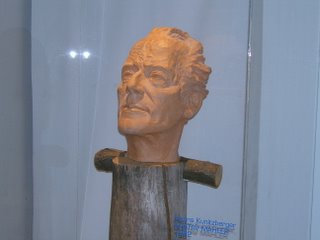
I was just about to take this picture when a young attendant walked up and saw my camera, "Excuse me, sir, you can't take pictures in the museum." I looked at her with woeful eyes and said, "Just one - I promise." She winked, "As long as I don't see it," as she passed into another room.
Without camera, I proceeded through the museum, which tells the story of the Vienna Philharmonic, its commitment to relatively democratic ideals in performance, and to the incredible list of conductors of the orchestra for the last two hundred years. I enjoyed the exhibit about the orchestra but was very anxious to get through this section, through the section on how sound is created and forms music, and various experimental and contemporary forms of music. I was ready for the 4th floor - the section on great composers. I patiently plodded through the composers most people worship, waiting at each turn to find Mahler. When I got there it was like entering a sanctuary. There was another person in the room who was equally taken but the pictures, artifacts, and the beautiful music playing in the background - some of Mahler's most profoundly beautiful pieces, including the adagietto from Symphony No. 5, his love prayer to his wife, Alma.
Mahler was born in 1860 of a Jewish peasant family. His parents were difficult and had health problems. He was not a good student, struggling with traditional studies. Nevertheless, he taught himself what he needed to know and found early on that he had a great gift for music. His father was urged to take Gustav to Vienna, which he did. From that time on, Mahler's life of composing and conducting unfolded in both meteoric and tempestual ways. His creative genius was such that he had difficulty in relationships, struggling to find the love of his life until he found Alma. He rose to be the conductor of the Vienna Opera House orchestra when he directed the Beethoven No. 9 by memory, effectively putting his predecessor out on the street in one night. Periods of isolation and brooding, coupled with the loss of his eldest daughter and eventual unfaithfulness of Alma, pushed him deeper into depression and finally therapy with none other than the man himself, Sigmund Freud. Ultimately, Mahler left Vienna, posting his resignation on the Opera House door and walking out. His last performance in Vienna was his Symphony No. 2, "The Resurrection." He served as the director of the New York Philharmonic, only to return to Vienna within a short time. He died in 1911 of heart complications. The details of Mahler's life reinforced some of what I had known, but telling more about the very difficult life story of an artistic genius who never really found a home.
As I was about to end my time at the Haus der Musik, I saw the same attendant who winked at my picture taking earlier in the evening. I asked her why there was so little about Mahler around the city, other than what I found in this museum. She said that the truth is that Vienna is very ambivalent about Mahler. She said that for most of the 20th century Mahler was not played at all in the city. Several years ago, "The Resurrection" was performed again. My fantasy is that it might have been a sort of "welcome home, Gustav" concert. I had known that Mahler was buried in Vienna and I asked the attendant where. She described a small cemetery quite a ways out of the city. I got the directions, tried to figure out if I could negotiate the transportation and if I had the time to go visit the burial site of my favorite of composers. As fate would have it, I didn't go. In retrospect, I think it's best. I don't know if I could have stood there in the darkness with him alone.
I will come back...
I had noticed throughout my journey around the city that there are monuments to Mozart, Strauss, and Beethoven all over the place. But, not one sign of Gustav Mahler, my personal and enthusiastic favorite. I figured that the Haus der Musik had to include him. To my great satisfaction, I purchased my ticket, almost ran up the flight of stairs only to find the bust of Mahler as the first thing to greet me.

I was just about to take this picture when a young attendant walked up and saw my camera, "Excuse me, sir, you can't take pictures in the museum." I looked at her with woeful eyes and said, "Just one - I promise." She winked, "As long as I don't see it," as she passed into another room.
Without camera, I proceeded through the museum, which tells the story of the Vienna Philharmonic, its commitment to relatively democratic ideals in performance, and to the incredible list of conductors of the orchestra for the last two hundred years. I enjoyed the exhibit about the orchestra but was very anxious to get through this section, through the section on how sound is created and forms music, and various experimental and contemporary forms of music. I was ready for the 4th floor - the section on great composers. I patiently plodded through the composers most people worship, waiting at each turn to find Mahler. When I got there it was like entering a sanctuary. There was another person in the room who was equally taken but the pictures, artifacts, and the beautiful music playing in the background - some of Mahler's most profoundly beautiful pieces, including the adagietto from Symphony No. 5, his love prayer to his wife, Alma.
Mahler was born in 1860 of a Jewish peasant family. His parents were difficult and had health problems. He was not a good student, struggling with traditional studies. Nevertheless, he taught himself what he needed to know and found early on that he had a great gift for music. His father was urged to take Gustav to Vienna, which he did. From that time on, Mahler's life of composing and conducting unfolded in both meteoric and tempestual ways. His creative genius was such that he had difficulty in relationships, struggling to find the love of his life until he found Alma. He rose to be the conductor of the Vienna Opera House orchestra when he directed the Beethoven No. 9 by memory, effectively putting his predecessor out on the street in one night. Periods of isolation and brooding, coupled with the loss of his eldest daughter and eventual unfaithfulness of Alma, pushed him deeper into depression and finally therapy with none other than the man himself, Sigmund Freud. Ultimately, Mahler left Vienna, posting his resignation on the Opera House door and walking out. His last performance in Vienna was his Symphony No. 2, "The Resurrection." He served as the director of the New York Philharmonic, only to return to Vienna within a short time. He died in 1911 of heart complications. The details of Mahler's life reinforced some of what I had known, but telling more about the very difficult life story of an artistic genius who never really found a home.
As I was about to end my time at the Haus der Musik, I saw the same attendant who winked at my picture taking earlier in the evening. I asked her why there was so little about Mahler around the city, other than what I found in this museum. She said that the truth is that Vienna is very ambivalent about Mahler. She said that for most of the 20th century Mahler was not played at all in the city. Several years ago, "The Resurrection" was performed again. My fantasy is that it might have been a sort of "welcome home, Gustav" concert. I had known that Mahler was buried in Vienna and I asked the attendant where. She described a small cemetery quite a ways out of the city. I got the directions, tried to figure out if I could negotiate the transportation and if I had the time to go visit the burial site of my favorite of composers. As fate would have it, I didn't go. In retrospect, I think it's best. I don't know if I could have stood there in the darkness with him alone.
I will come back...
The Habsburgs and the Hofburg
Much of the reason that Vienna is such a music, art, and architecture center is the result of the Habsburg family who ruled Austria and varying portions of the rest of Europe from 1273 to 1918. For part of this period, the Habsburgs rule the Holy Roman Empire and were devoted Catholics. They married across countries for political and military power and they amassed wealth that is simply stunning. I visited only two of their palaces in Vienna - the Schonbrunn (the summer home in the Vienna Woods with a modest 1,400 rooms) and the Hofburg (the winter home in the heart of Vienna with 2,400 rooms). The first picture is the exterior of the Hofburg.
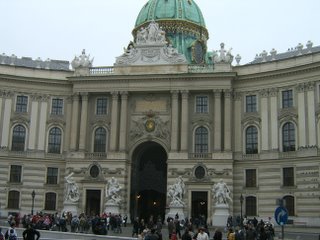
The next to last Emperor, Francis Joseph, and his wife, the Empress Elisabeth of Bavaria (nicknamed Sissi) ruled from 1848-1916 at which point Francis Joseph died, yielding the thrown to Charles who only held it two years before relinquishing it in pesant uprising. WWI and WWII both had heavy influence on changing the culture away from monarchy to new democratic governments. Elisabeth (Sissi) was known the world over for her beauty, for the opulence of her lifestyle, and eventually from distancing herself from Francis Joseph due to disagreements about the monarchy and affairs of state. She was stabbed and died, giving rise to many "Sissi" myths that spawned books, movies, etc. during the beginning of the 20th century.
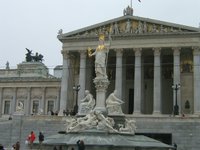
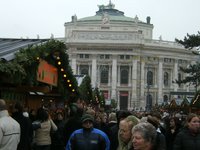
After viewing the royal apartments in the Hofburg, I enjoyed roaming throughout the area, first stopping by the Parliament (picture above), then attending a beautiful Christmas market placed between the Rathaus and the Burgtheater (to the right).

The next to last Emperor, Francis Joseph, and his wife, the Empress Elisabeth of Bavaria (nicknamed Sissi) ruled from 1848-1916 at which point Francis Joseph died, yielding the thrown to Charles who only held it two years before relinquishing it in pesant uprising. WWI and WWII both had heavy influence on changing the culture away from monarchy to new democratic governments. Elisabeth (Sissi) was known the world over for her beauty, for the opulence of her lifestyle, and eventually from distancing herself from Francis Joseph due to disagreements about the monarchy and affairs of state. She was stabbed and died, giving rise to many "Sissi" myths that spawned books, movies, etc. during the beginning of the 20th century.


After viewing the royal apartments in the Hofburg, I enjoyed roaming throughout the area, first stopping by the Parliament (picture above), then attending a beautiful Christmas market placed between the Rathaus and the Burgtheater (to the right).
Finding the music
I think the title of this post is probably a metaphor for my life. It was certainly the inspiration for this weekend. As I said in the previous post, there was more music than I could absorb so Friday night I started out with one concert that had no competition - it was an Advent Meditation organ concert at St. Augustinkirche. The music was Bach played on one organ and Messian played on a French Baroque organ - both were magnificent.
My options after the organ meditation were to go to St. Stephen's for an advent concert at 8:30 p.m. However, I knew from my afternoon walk that the Vienna Opera House was playing Verdi's "La Traviata." I asked several people about how to get tickets and was told in no uncertain terms that my question was ridiculous. One person gave me a glimmer of hope saying that sometimes you could go shortly before the performance and there might be a seat open. I ran from St. Augustinkirche to the Vienna Opera House to get there 10 minutes before the opening, only to find that there's a side entrance for standing room only seats - I jumped to the end of the line and took my chances. My European luck panned out again - I snagged "La Traviata" at one of the world-reknowned Opera Houses for $2 Euro; if you're not familiar with opera, the tickets usually start at $75-$100 and go up to hundreds per seat. I hardly noticed the stand as my entire being was taken to another dimension watching this incredible performance.
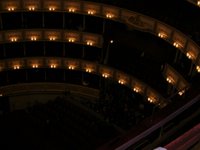

The picture above is of the interior of the theatre during intermission. The only other picture (although dark) is of the grand staircase leading to the theatre. (If you click on the picture, it gets bigger and a littler easier to see.)
I cannot tell you how special this evening was. The only thing missing was Diane, my Violetta (she's the heroine), except that Diane brings considerably less drama into my world, which is a good thing (you'll only get this if you know the story).
My options after the organ meditation were to go to St. Stephen's for an advent concert at 8:30 p.m. However, I knew from my afternoon walk that the Vienna Opera House was playing Verdi's "La Traviata." I asked several people about how to get tickets and was told in no uncertain terms that my question was ridiculous. One person gave me a glimmer of hope saying that sometimes you could go shortly before the performance and there might be a seat open. I ran from St. Augustinkirche to the Vienna Opera House to get there 10 minutes before the opening, only to find that there's a side entrance for standing room only seats - I jumped to the end of the line and took my chances. My European luck panned out again - I snagged "La Traviata" at one of the world-reknowned Opera Houses for $2 Euro; if you're not familiar with opera, the tickets usually start at $75-$100 and go up to hundreds per seat. I hardly noticed the stand as my entire being was taken to another dimension watching this incredible performance.


The picture above is of the interior of the theatre during intermission. The only other picture (although dark) is of the grand staircase leading to the theatre. (If you click on the picture, it gets bigger and a littler easier to see.)
I cannot tell you how special this evening was. The only thing missing was Diane, my Violetta (she's the heroine), except that Diane brings considerably less drama into my world, which is a good thing (you'll only get this if you know the story).
Vienna (Weiner) - center of the musical world
For my final solo travel I decided to take the long trek to Vienna (Weiner in Austrian) for the weekend. I took a night train on Thursday night, allowing me Friday and Saturday for touring, and then returning over night on Saturday night/Sunday. My major motivation to go to Vienna was because of my life-long dedication to music. Vienna was clearly the center of classic music for the 18th, 19th, and the beginning of the 20th century. Such composers as Mozart, Haydn, Beethoven, Schubert, Strauss, Brahms, Bruckner, Mahler, Berg, and Schoenberg all lived, composed, and/or directed in Vienna. My fantasies about the experience did not disappoint me!
Of course, my first challenge was finding a place to stay. I went to the Information center and was told that the entire city was booked up - yeah, sure. I think it was a ploy to get me to bump up what I was willing to pay for a room. Well, it worked. I paid $90 Euro which is almost double what I've been paying. However, it was a great hotel and in the middle of everything. The first picture is of the outside of the hotel on Neur Markt, right around the corner from shopping, St. Stephen's Cathedral, St. Peter's Catherdral, the Hofburg, and lots more.
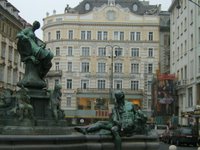
Because I hadn't cleaned up, I exercised with a quick walk, came back to shower, and dressed up to hit the streets. I didn't know for sure what I was going to do for the evening/night but I had already scoped out all the music - there were so many options I had to narrow it down (more on that later). I strolled through the streets where there were thousands of shoppers out for the holidays. Many of the city streets are pedestrian walk-ways and beautifully lighted (second picture). There was soft snow floating through the air and people enjoying the festive holiday spirit. Seeing people was really wonderful but I do have a slight "heads-up" for those who want to travel this wonderful city... Many of the people are very abrupt, impatient, and unfreindly - a marked contrast to the people of Luzern or to those in Paris for that matter. I don't know if it was the shopping atmosphere or what but some of the pedestrians were as agressive as Amsterdam cyclists - pretty freightening.
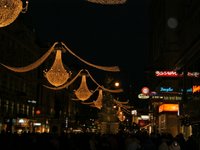
Of course, my first challenge was finding a place to stay. I went to the Information center and was told that the entire city was booked up - yeah, sure. I think it was a ploy to get me to bump up what I was willing to pay for a room. Well, it worked. I paid $90 Euro which is almost double what I've been paying. However, it was a great hotel and in the middle of everything. The first picture is of the outside of the hotel on Neur Markt, right around the corner from shopping, St. Stephen's Cathedral, St. Peter's Catherdral, the Hofburg, and lots more.

Because I hadn't cleaned up, I exercised with a quick walk, came back to shower, and dressed up to hit the streets. I didn't know for sure what I was going to do for the evening/night but I had already scoped out all the music - there were so many options I had to narrow it down (more on that later). I strolled through the streets where there were thousands of shoppers out for the holidays. Many of the city streets are pedestrian walk-ways and beautifully lighted (second picture). There was soft snow floating through the air and people enjoying the festive holiday spirit. Seeing people was really wonderful but I do have a slight "heads-up" for those who want to travel this wonderful city... Many of the people are very abrupt, impatient, and unfreindly - a marked contrast to the people of Luzern or to those in Paris for that matter. I don't know if it was the shopping atmosphere or what but some of the pedestrians were as agressive as Amsterdam cyclists - pretty freightening.

Subscribe to:
Posts (Atom)